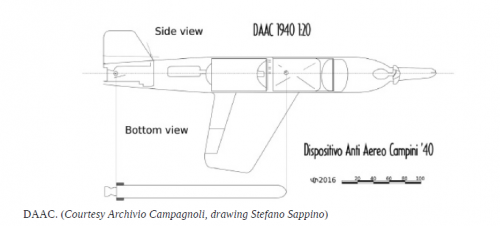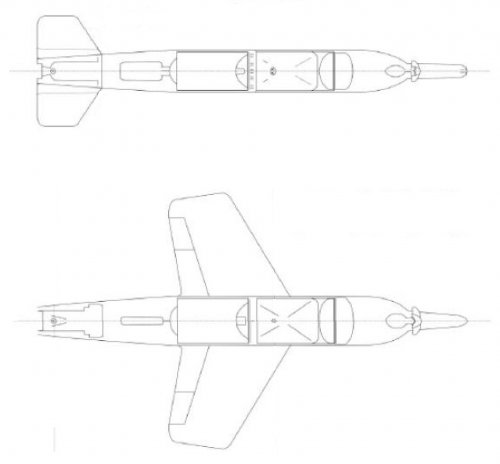Temistocle
ACCESS: Secret
- Joined
- 9 December 2009
- Messages
- 246
- Reaction score
- 505
Hi,
first of all, Happy New Year at all.
Secondly, I am reading the book "Aircraft Carrier Impero", authors Davide F. Jabes and Stefano Sappino. We talked about it here:
https://www.secretprojects.co.uk/forum/index.php/topic,30931.0.html
At page 159-163 there are some notes about the "Dispositivo Anti Aereo Campini" (Campini AA Device), a missile to be installed on the aircraft carrier (Campini was the developer of the engine of the Campini Caproni CC2):
AC means "Archivio Campagnoli"; Campagnoli was an Ansaldo naval engineer.
I did not have any info about this Italian antiaircraft missile; I am absolutely confident about the research job of the two authors on the Campagnoli's archive, but I am a bit skeptical about the DAAC, for example, why the trials were made in Tripolitania (Libya) instead of Italy? For a technical advanced project as an antiaircraft missile (rocket engine, guiding device and so on) in Italy there were some artillery range useful for this purpose. Maybe Libya has been chosen to keep secret the project, i.e. far away from spies, and/or because it has large uninhabited areas. France set a missile test center at Hammaguir in Algeria after the war, but they tested there missiles with a longer range than DAAC.
In every case Campagnoli's Archive is the only source with info about DAAC. Or not?
A couple of pictures below, with a comparison with the Hs 117 Schmetterling; the third one is a "cut and paste" two view figure to demonstrate the similarities between DAAC-Schmetterling on the airframe.
Some other info and pics in the following websites:
https://mediadrumworld.com/2018/08/03/29945/
https://fonzeppelin.livejournal.com/51845.html
(in russian)
Any other info is really appreciated.
first of all, Happy New Year at all.
Secondly, I am reading the book "Aircraft Carrier Impero", authors Davide F. Jabes and Stefano Sappino. We talked about it here:
https://www.secretprojects.co.uk/forum/index.php/topic,30931.0.html
At page 159-163 there are some notes about the "Dispositivo Anti Aereo Campini" (Campini AA Device), a missile to be installed on the aircraft carrier (Campini was the developer of the engine of the Campini Caproni CC2):
Prior to 1940 in Italy, Campini developed the DAAC (acronym for Dispositivo Anti Aereo Campini), a rocket-propulsion weapon with anti-aircraft goals. The weapon was radio guided and was experimented in five units in April 1940 in Libya (Tripolitania) against captive balloons, with success.
...
The Ansaldo designers immediately recognised the excellent potential of the DAAC as an anti-ship weapon. Its range was larger than the big calibre guns and it could be launched from simply modified naval gun carriages (big or medium units). It also had the ability to be radio guided and its speed made it much more interesting, in terms of damage caused, than the naval shells. The explosive charge was, also in the ‘light’ version, five times greater than the charge in one 381-mm shell (but obviously with very different penetration capabilities).
The loaded weapon weight (approximately a half of a 381-mm shell) made it easy to be moved on board. However, securing the engines liquid fuels on-board still remained a problem.
In the AC, there is mention of various contacts regarding the DAAC with the Regia Marina and the Regia Aeronautica, probably starting in 1940; however, in Campagnoli’s words, ‘there is lack of interest to continue’—probably the General Staff (in the original text, it says SM, it could also be referring to Supermarina) adduced the issues to budget problems, operational difficulties, and, again in Campagnoli’s words, ‘inability to foresee its potential’.
In 1942, alter inconclusive negotiations with the Regia Marina, Campini was directed by engineer Astegno of Ansaldo to contact the Kriegsmarine for the development of small watercrafts with water-jet propulsion, which had already performed excellently during trials.
A contract was closed for 50,000 Reichsmarks (approximately 600,000 Euro in 2016, using gold as an exchange medium) with the Kriegsmarine, and the development facility was placed, upon request of the Germans, at the Garda Lake, with the goal of keeping it near the Caproni plants and safe from aerial raids.
However, Campini ‘was anyway convinced that the collaboration with the Kriegsmarine was one-sided and in fact, it was’. Presumably, the scepticism of the possibility of a loyal and equal collaboration with the Germans led Ansaldo (in 1942) to consider other ways to achieve their goals, thus acquiring the ‘Gunnarson document’.
German DAAC Incarnation: Henschel Hs 117 Schmetterling
After the trials in Tripolitania in 1940, engineer Campini decided to continue the development of the weapon with German BMW, which, according to him, had a more advanced engine. In 1943, this collaboration led to the German Henschel Hs 117 Schmetterling (‘butterfly’).
In September 1942, Goring approved, after Hitlers approval on 1 September 1942, the restart of the programme of anti-aircraft rocket weapons, given the impossibility for the Luftwaffe to block Allied access to German skies. In the document of technical specifications of 25 September 1942, the first reference to what would eventually become the Henschel 117 can be found. Its development occurred despite numerous difficulties in building the testing location and assuring the required manpower.
The Hs 117 was one of the anti-aircraft weapon among the many developed in Germany] during the war, without a centralised coordination (rivalries and competition among different industrial firms were common) until at least 1944. The tactical aim was the necessity to intercept enemy aircraft at altitudes not reachable by anti-aircraft artillery.
Between May and July 1944, only five Henschel 117 test models were produced. The expectation* of being able to produce initially 3,000 units a month and 5,000 with a tuned production cycle was pure fantasy, given the conditions of the war and the industrial supplies at the time.
The specifications, as well as the lines and technical solutions of the Hs 117, closely follow those of the DAAC 1940 with the difference being that it has two solid combustible boosters for take-offs instead of one and a higher top speed due to its intended use as anti-aircraft weapons. The two boosters were meant to be unhooked after 600 metres of flight—cruising speed is 210 metres per second.
...
The direct derivation of the German weapon from the Campini studies is recorded in the AC. 'Campini developed two engines, a first one in 1940 and a second in Germany in 1943 with BMW'.
AC means "Archivio Campagnoli"; Campagnoli was an Ansaldo naval engineer.
I did not have any info about this Italian antiaircraft missile; I am absolutely confident about the research job of the two authors on the Campagnoli's archive, but I am a bit skeptical about the DAAC, for example, why the trials were made in Tripolitania (Libya) instead of Italy? For a technical advanced project as an antiaircraft missile (rocket engine, guiding device and so on) in Italy there were some artillery range useful for this purpose. Maybe Libya has been chosen to keep secret the project, i.e. far away from spies, and/or because it has large uninhabited areas. France set a missile test center at Hammaguir in Algeria after the war, but they tested there missiles with a longer range than DAAC.
In every case Campagnoli's Archive is the only source with info about DAAC. Or not?
A couple of pictures below, with a comparison with the Hs 117 Schmetterling; the third one is a "cut and paste" two view figure to demonstrate the similarities between DAAC-Schmetterling on the airframe.
Some other info and pics in the following websites:
https://mediadrumworld.com/2018/08/03/29945/
https://fonzeppelin.livejournal.com/51845.html
(in russian)
Any other info is really appreciated.



